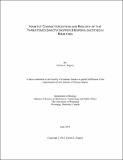Habitat Characterization and Biology of the Threatened Dakota Skipper (Hesperia dacotae) in Manitoba

View Open
Metadata
Show full item recordAuthor
Rigney, Christa Leigh
Date
2013-10-09Citation
Rigney, Christa Leigh. Habitat Characterization and Biology of the Threatened Dakota Skipper (Hesperia dacotae) in Manitoba; A thesis submitted to the Faculty of Graduate Studies in partial fulfillment of the requirements for the Masters of Science degree, Department of Biology, Masters of Science in BioScience, Technology and Public Policy, The University of Winnipeg. Winnipeg, June 2013.
Abstract
The Dakota Skipper, Hesperia dacotae, is a threatened butterfly restricted to fragmented prairies in the Interlake, southwestern Manitoba and southeastern Saskatchewan in Canada. Currently there is limited data on the life history and habitat requirements in Canada to implement effective conservation measures. The purpose of this study was to determine key biological and physical habitat requirements within existing Dakota Skipper sites in Manitoba. Four Dakota Skipper sites in the Interlake and four sites in southwestern Manitoba were selected to measure the composition of vegetation and flowers in bloom during the flight period, and soil characteristics. Adult populations were also surveyed at each site. Sites were generally subject to annual fall haying and several sites exhibited adverse impacts associated with flooding, succession, encroachment by invasive plants, vehicle damage, cattle grazing or wildfire.
There was considerable overlap in vegetation and flower composition between sites, and between the Interlake and southwest Manitoba regions. The most abundant plant species at sites in the vegetation surveys included: Agropyron repens, Andropogon gerardii, Andropogon scoparius, Deschampsia caespitosa, Poa compressa, Poa cusickii, Scolochloa festucacea and Sonchus arvensis. In the flower surveys the most abundant plants included: Zygadenus elegans, Melilotus alba, Petalostemon candidum, Petalostemon purpureus, Campanula rotundifolia, Lobelia spicata, Crepis runcinata, Rudbeckia hirta and Solidago ptarmicoides. Four previously documented and ten possible larval food plant species were recorded as well as 34 previously documented or possible adult nectar plant species. There was no significant difference between regions in plant species diversity measures (Shannon diversity, Shannon eveness, Simpson reciprocal and Berger-Parker reciprocal indices). Indicator Species Analysis identified ten species in the vegetation surveys and 15 species in the flower surveys as significant regional indicators. Principal Component Analyses (PCA) showed several species of plants and flowers associated with either a region or site. Soil and soil-related parameters measured at sites included: bare ground, duff layer, soil pH, soil moisture, soil compaction, soil bulk density, soil particle size and texture, soil organic matter content, soil available calcium, magnesium and sodium cation content, and air temperature and relative humidity at the soil level. There were significantly higher levels of the mean duff layer, soil pH measured at the University of Winnipeg laboratory, soil moisture measured in the field, mean soil compaction and compaction at 20, 30 and 40 cm, clay content, silt content, organic matter content and available magnesium content in the Interlake region and higher levels of sand content in southwestern Manitoba. The air temperature during the “larval period” was also significantly higher in the Interlake in 2010 and the mean of 2010/2011, while the air relative humidity was higher in the southwest in 2010, 2011 and the mean of both years. Redundancy Analyses (RDAs) showed associations between the soil parameters and vegetation or flower species, explaining considerable amounts of variation (58 to 74% on first three axes), and with clay content and available magnesium cation content significantly higher in the Interlake.
The Dakota Skipper flight period ranged from 13 to 19 days, with up to 15 days difference between the start date in 2010, 2011 and 2012. Populations of Dakota Skipper appear to be on the decline at all eight sites when compared to past surveys, and Dakota Skipper were absent from three of the sites where they were previously documented. The population estimate for the site with the most skippers (Site H) using Insect Count Analyzer (INCA) software ranged from 277 to 332 individuals in 2011. Dakota Skipper adults were observed nectaring upon twelve species of flowering plants, six of which are new records for North America: Melilotus alba, Petalostemon purpureus, Oenothera biennis, Lobelia spicata, Crepis runcinata and Solidago ptarmicoides. The majority of nectaring observed was upon Rudbeckia hirta. Amplification of a region of cytochrome c oxidase I (COI) gene from a single Dakota Skipper mid-leg sampled in a non-lethal manner was demonstrated to be as effective as conventional lethal sampling and identified two polymorphic sites.
Certain floral species are required by Dakota Skipper for shelter, and larval and adult feeding. A set of key vegetation and soil attributes that characterize Dakota Skipper sites were developed as a guide to identify critical habitat in Manitoba. Comparisons of present land use at Dakota Skipper sites, flora, edaphic factors and adult densities were examined and potential relationships are discussed. Management recommendations and future research direction based on these results are provided.
